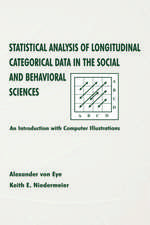Structural Equation Modeling: Applications in Ecological and Evolutionary Biology
Editat de Bruce H. Pugesek, Adrian Tomer, Alexander Von Eyeen Limba Engleză Hardback – 22 ian 2003
| Toate formatele și edițiile | Preț | Express |
|---|---|---|
| Paperback (1) | 445.32 lei 43-57 zile | |
| Cambridge University Press – 18 mar 2009 | 445.32 lei 43-57 zile | |
| Hardback (1) | 896.66 lei 43-57 zile | |
| Cambridge University Press – 22 ian 2003 | 896.66 lei 43-57 zile |
Preț: 896.66 lei
Preț vechi: 1042.63 lei
-14% Nou
Puncte Express: 1345
Preț estimativ în valută:
171.58€ • 179.59$ • 142.81£
171.58€ • 179.59$ • 142.81£
Carte tipărită la comandă
Livrare economică 31 martie-14 aprilie
Preluare comenzi: 021 569.72.76
Specificații
ISBN-13: 9780521781336
ISBN-10: 0521781337
Pagini: 424
Ilustrații: 74 b/w illus. 61 tables
Dimensiuni: 152 x 229 x 24 mm
Greutate: 0.8 kg
Editura: Cambridge University Press
Colecția Cambridge University Press
Locul publicării:Cambridge, United Kingdom
ISBN-10: 0521781337
Pagini: 424
Ilustrații: 74 b/w illus. 61 tables
Dimensiuni: 152 x 229 x 24 mm
Greutate: 0.8 kg
Editura: Cambridge University Press
Colecția Cambridge University Press
Locul publicării:Cambridge, United Kingdom
Cuprins
Part I. Theory: 1. Structural equation modelling: an introduction Scott L. Hershberger, George A. Marcoulides and Makeba M. Parramore; 2. Concepts of structural equation modelling in biological research Bruce H. Pugesek; 3. Modelling a complex conceptual theory of population change in the Shiras moose: history and recasting as a structural equation model Bruce H. Pugesek; 4. A short history of structural equation models Adrian Tomer; 5. Guidelines for the implementation and publication of structural equation models Adrian Tomer and Bruce H. Pugesek; Part II. Applications: 6. Modelling intra-individual variability and change in bio-behavioural developmental processes Patricia H. Hawley and Todd D. Little; 7. Examining the relationship between environmental variables and ordination axes using latent variables and structural equation modelling James B. Grace; 8. From biological hypotheses to structural equation models: the imperfection of causal translation Bill Shipley; 9. Analysing dynamic systems: a comparison of structural equation modelling and system dynamics modelling Peter S. Hovmand; 10. Estimating analysis of variance models as structural equation models Michael J. Rovine and Peter C. M. Molenaar; 11. Comparing groups using structural equations James B. Grace; 12. Modelling means in latent variable models of natural selection Bruce H. Pugesek; 13. Modeling manifest variables in longitudinal designs - a two-stage approach Bret E. Fuller, Alexander von Eye; Philip K. Wood and Bobby D. Keeland; Part III. Computing: 14. A comparison of the SEM software packages Amos, EQS and LISREL Alexander von Eye and Bret E. Fuller; Index.
Descriere
Structural equation modelling (SEM) is a technique that is used to estimate, analyse and test models that specify relationships among variables.




















